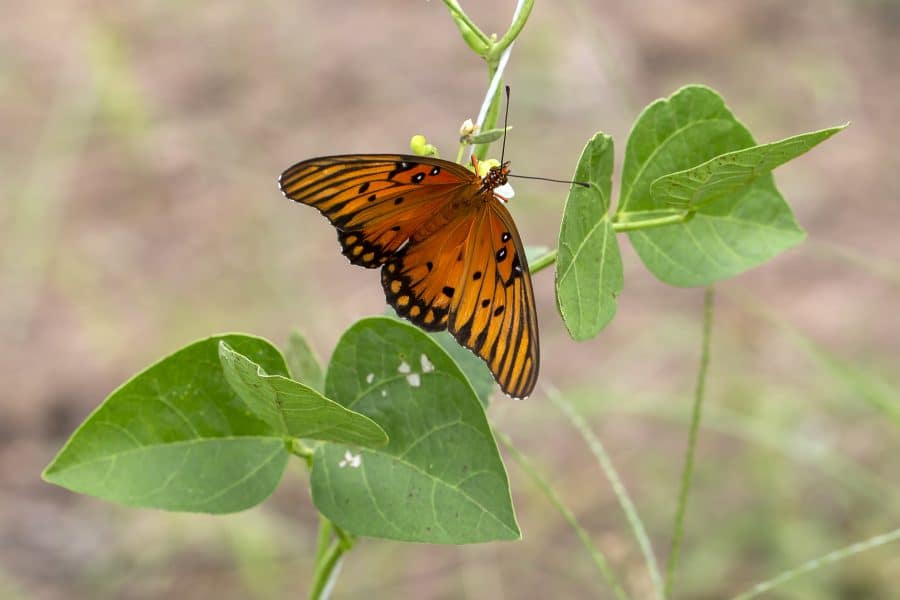Climate change causes drastic, unpredictable weather with blended seasons and extreme patterns. In Oklahoma, that has resulted in more days over 105 degrees in the summer, greater occurrences of severe weather in the spring, shorter autumns and warmer winters than previously recorded.
Like many pollinators, the monarch butterfly’s population has decreased in recent years due to those changes, specifically severe temperatures. Monarchs use Oklahoma and the Midwest as a crucial part of their migration, traveling as far north as Canada for the summer and back south to the mountains of Central Mexico for the winter. It takes four to six generations of butterflies to complete the cycle, covering as many as 3,000 miles. Many people fondly remember monarchs in their yards and gardens.

“My uncle would stick out his index finger, and the butterfly would land on his finger. And it would just kind of stay there and walk around. And everyone else put out their fingers, and it never landed on their finger,” said environmental anthropologist and Tribal member Yancey Orr, Ph.D. “And considering their lifespan, it could not possibly be the same butterfly. It just happened summer and summer and summer.”
Orr studies human environmental knowledge at the University of Maryland. In a time of easy access to information and advanced technology, people generally view knowledge in terms of educational institutions and facts. Orr said lived experiences and physical interaction also provide crucial learning opportunities.
“Things that (people) are surrounded by every year or every day that they ignore is not just important for how people experience the world, but it’s also very important about what we collectively decide to do or not to do regarding being stewards of the natural world or one another,” Orr said.
Despite a population decrease of up to 90 percent during recent years, monarchs are not listed as a threatened or endangered species.
Awareness and significance
Orr researches human perception, including a disconnection from the natural world perpetuated by increases in screen time throughout the last three decades.
“We’re finding that when people interact with the online world, their perception and what they learn is skewed according to existing beliefs,” Orr said. “And it’s really difficult to shake those beliefs out of people so that they actually see what is being presented in the world.”
Many Indigenous cultures place importance on a correlation with the earth, including Great Lakes region tribes such as the Potawatomi. Nishnabé people passed down those beliefs for generations, ensuring their survival through colonialism and forced removals.
“One tradition, both in American Indian communities or American Indian culture and also in the early history of evolution, was the important role that sort of very small creatures had in actually creating the world around us. So we can think in some ways about European views of nature preference to larger animals, game animals, etc. while ignoring, sort of, insects,” Orr said.
Pollinators and other arthropods, including monarchs, play crucial roles in their larger ecosystems. However, modern humans often perceive them as contributing less based on their physical size.
Due to their migration patterns, monarchs fly thousands of miles throughout the year and spend a few weeks in their reproductive destinations along the way. They reside the longest in Mexico for a few months between October and the beginning of March, depending on weather patterns. Although ephemeral, during their short lifetimes, they pollinate plants across North America and CPN land, making them a keystone species.
“These things have been pushed to the margins of survival by processes that are much bigger and more indifferent to them,” Orr said. “And so in some ways, those monarch butterflies finding refuge in Pottawatomie County on their migration patterns, it’s something that we could relate to as people who had to migrate for generations and generations, due to the indifference of others.”
Action
In 2016, Citizen Potawatomi Nation partnered with the Tribal Alliance for Pollinators to plant and preserve milkweed at the CPN Eagle Aviary. Milkweed provides a critical source of food for larva before they form a chrysalis, turn into butterflies, and continue on their path. Orr said the Tribe’s work carries weight for several reasons.
“One is the ecological importance, both in their function of the ecosystem, but also in the fact of how old they are and their right to exist, which is independent of how long they spend with us or how much of a part of our life those things may be.”
Recent record-setting temperatures in Oklahoma disrupted the narrow conditions they require for breeding. In 2015, The Washington Post reported the monarch’s population declined 970 million in 15 years, and their numbers reduced to 30 million across the continent. Orr finds the swift reduction due to both pesticide usage and climate change alarming, especially since participation in a digital world provides an easy avenue to ignore monarchs’ disappearance.
“How do we make that kind of virtual world that we created augment or care for the real world? That’s a big question that we have to answer. And I don’t know if we have that answer right now, but it’s a curious and significant place to be sort of historically within our worlds,” he said.
While individual efforts to reduce pollution and use of greenhouse gases collectively make a difference, significant impact as a society requires large-scale, conscious decision making. In August 2014, the Center for Biological Diversity, the Center for Food Safety, Xerces Society, and Lincoln Brower, Ph.D., filed a petition with the U.S. Fish and Wildlife Service for protection of the monarch butterfly under the Endangered Species Act. The USFWS delayed the appeal for an additional 18 months in June 2019, moving the deadline to December 2020.
Read more about the Tribe’s efforts at cpn.news/pollinators.
